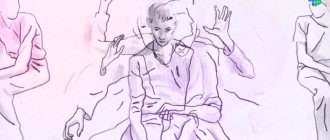Catatonia is a psychopathological syndrome with a predominance of psychomotor and autonomic disorders in the motor sphere, characterized by a clinical picture of agitation or stupor, which is unmotivated.
In the International Classification of Diseases (ICD-10), the disorder is considered within the framework of catatonic schizophrenia. This interpretation makes it difficult to diagnose the disorder.
Catatonic states of excitement and stupor can quickly replace each other. They arise autochthonously and are functional in nature. Catatonia may not be accompanied by stupefaction (lucid), or may be accompanied by oneiric stupefaction.
Catatonic stupor is characterized by increased muscle tone and immobility. Stupor can develop quickly or gradually. With gradual development, slowness, angular movements, prolonged freezing in one place (substupor), etc. initially appear. Over time, the severity of stupor increases.
Variants of motor stupor:
- Depressive;
- Catatonic;
- Hallucinatory;
- Apathetic;
- dissociative (“hysterical”);
- affective-shock.
Types of motor excitation:
- Manic;
- Anxious;
- Hallucinatory;
- Delusional;
- Affective-shock;
- Dissociative (“hysterical”);
- Against the background of confusion: delirium, twilight confusion.
Catatonic excitation develops suddenly, often rapidly moving from a state of stupor.
Catatonia is also characterized by other clinical manifestations:
Mutism is an unmotivated refusal to speak during normal functioning of the speech apparatus. Passive and active negativism is an unmotivated refusal to perform actions (for example, changing a position) or performing opposite actions. Motor and speech stereotypies - pretentiousness of movements and facial expressions. Echopraxia and echolalia are unmotivated repetition of the actions and phrases of others.
Causes
Specific reasons for the development of catatonia have not been established. The disorder may be initiated due to:
- Concomitant mental disorders (depression, bipolar disorder, schizophrenia, schizotypal disorder, acute psychosis);
- Substance and alcohol use;
- Neurological diseases (epilepsy, multiple sclerosis, Parkinson's disease, brain tumors, dementia);
- Metabolic and endocrine disorders (Cushing's syndrome, hyperthyroidism, Sheehan's syndrome);
- Autoimmune diseases (systemic lupus erythematosus, antiphospholipid syndrome), etc.
Genetic predisposition to certain mental disorders plays a great role. Some infectious diseases can also cause the development of catatonic stupor.
Results
Basic methods of motivation during stupor
- 1. Debriefing
- 2. A few questions for yourself.
- 3. Make each next article better than the previous one.
- 4. Goal, plan, systematic approach—without this there will be no result!
Create a blog - what to go on stage
And answer an important question
!
Of course you know your worth
Do you have such a demand!?
Judge for yourself whether you learned something useful, and if you liked the article, subscribe and share with friends
Pathogenesis
There is no consensus on the pathogenesis of catatonia. Studies have shown that disruption of communication between cortical structures, the thalamus and the basal ganglia play an important role in the occurrence of catatonic symptoms, therefore, in addition to clinical assessment, when studying catatonia, it is worth taking into account the results of neuroimaging and neuropsychological examinations. The hypothesis is based on a lack of gamma-aminobutyric acid (GABA) in the basal ganglia. Normally, GABA reduces the intensity of emotional reactions, such as anger, fear or anxiety.
In modern literature, there are often cases of catatonia caused by abrupt withdrawal of drugs used to treat catatonic states and accompanying mental disorders. This therapy uses mechanisms to increase GABA activity in the basal ganglia, which has a positive therapeutic effect. With abrupt withdrawal of drugs, an increase in motor symptoms often occurs (the phenomenon of “rebound catatonia”).
It is possible that catatonia develops as a result of severe anxiety, in response to stress. Therefore, scientists suggest that catatonic states are directly related to affective and other mental disorders that are accompanied by symptoms of severe anxiety.
Stupor in the head: how to get rid of it - a simple debriefing
What is itching in one place? Does impatience give you rest? You know how to deal with obsessive desires.” He sighed, held his breath for ten seconds, and your desire became your inner strength.
So you say that you started a new business. But it's not going well! What was your business before this? Self-isolation, sofa, TV, computer, balcony!? Would you like to admit that blogging has become an enjoyable activity, moreover, exciting, and which has quietly begun to replace your previous hobbies? You wrote these correct lines, right?!
There is no more interesting activity!
This is honest, believe me, by God!
All you have to do is go online
You reach out to the blog with all your heart!
Symptoms
There are many clinical signs of catatonic syndrome. Symptoms are often related to the motor area. With catatonic stupor, the patient becomes numb or completely immobile. Muscle tone is increased, especially in the head and shoulder girdle. The chewing muscles are toned, the lips are pulled forward (proboscis symptom), the person lies on his back, holding his head above the pillow (the “air cushion” symptom). Less severe conditions occur in the form of catalepsy. Muscle tone may alternate with complete relaxation, and epileptiform seizures are sometimes observed. The state of catatonic excitement is characterized by incoherent speech, absurd rhyming, and echolalia.
In severe cases, the attack of stupor with catalepsy is prolonged, mutism, lack of reaction of the pupils to intense painful stimuli (Bumke's symptom), and persistent insomnia are noted.
Stupor may be accompanied by oneiric stupefaction, delusions and hallucinations. Motor disturbances manifest themselves in combination with a feeling of stiffness of the body and the inability to move, with stupor, or a feeling of muscle looseness with motor excitement.
In catatonic states, the following symptoms may occur:
- catatonic stupor or substupor - complete or partial immobility, often in a sitting or standing position;
- catalepsy - a person remains in one position for a long time;
- waxy flexibility - long-term preservation of the position that another person gives the patient;
- negativism—resistance when another person tries to change the patient’s position;
- mutism – prolonged silence;
- stereotypy - repeated monotonous movements;
- catatonic agitation - increased disordered motor activity;
- echolalia/echopraxia - copying the words and movements of another person;
- pretentiousness of facial expressions and movements.
In addition to the main symptoms, manifestations of disruption of the autonomic nervous system may occur. With catatonia, there may be an increase in body temperature to subfebrile, a feeling of thirst, increased blood pressure, and tachycardia. Often patients refuse water and food.
The detailed picture of catatonic stupor and agitation does not differ in clinical manifestations in adolescents and adults. Oneiric catatonia often occurs against the background of the manic phase in schizoaffective psychosis; it is much less common in depression and attacks of fur-like schizophrenia, especially in adolescents. Hebephrenic syndrome is characteristic of adolescence and the malignant course of schizophrenia. As a rule, catatonic symptoms appear against the background of this syndrome.
Fibril catatonia develops with symptoms of oneiric, neurological and somatic disorders. A febrile attack is characterized by manic-delusional, hallucinatory and depressive syndromes. With more pronounced psychosis, fantastic delirium appears. The patient is in a state of agitation or stupor.
Body temperature rises sharply to febrile and higher. There is no relationship with somatic and infectious diseases. Blood pressure rises, tachycardia and increased sweating are present. The person is in an excited state and feels very thirsty. Excitement gives way to stupor or sub-stupor. General health worsens. The feeling of thirst and hunger disappears, the skin becomes dry, and swelling appears. If assistance is not provided in a timely manner, congestion in the lungs, bedsores and other complications may develop.
Most often, attacks of febrile catatonia are observed in people 41-50 years old. They are characterized by a severe course and a high risk of death.
With primary manifestations of catatonia, you should immediately consult a doctor. With timely diagnosis and effective treatment, the condition can be normalized without further development of complications.
What is dissociative stupor
Dissociative dementia (dissociative stupor) is a movement disorder caused by trauma. It is characterized by mutism and complete or almost complete immobility, but does not cause any physical or mental impairment.
Develops as a result of excessive acute stress, severe social or interpersonal problems. The duration usually varies from a few minutes to several hours. The diagnosis is made based on clinical symptoms and data on the traumatic event. During the diagnostic process, other psychiatric and somatic pathologies are excluded. Treatment consists of psychotherapy and pharmacological therapy.
ICD-10
Surely, you have more than once been in a state of some kind of stupor, when it is impossible to make a decision, comprehend the problem, or draw a conclusion. Is this condition a disease? No. But it is dissociative stupor, which is caused by trauma, mental dysfunction, that is a disease.
In the international classifier ICD-10, dissociative stupor is allocated to a separate category of diseases - F44.2 Dissociative stupor.
Dissociative stupor is a disease caused by a traumatic situation or stress.
Level of consciousness during stupor
As for consciousness in this situation, the patient is quite vague and cannot answer any questions; reactions are short-lived, even to strong stimuli.
Biological basis
Man is not as far from animals as we would like to think. This condition also occurs in the animal world, and is not so rare. Think of a rabbit, stunned, waiting to be swallowed by a boa constrictor. Or a chicken that freezes when its head is placed under its wing.
In the animal kingdom, stupor is a “mercy”: it allows you to die painlessly, rendering the victim unconscious and leaving him with no choice but to surrender. In this state, the pain subsides and merciful insensibility sets in.
Psychological trauma can be unbearable for a person, the situation can be perceived as hopeless and unpromising, and this is an important element in causing stupor.
Classification
Catatonic states are classified based on the severity of clinical manifestations and the nature of the course of the disorder. Currently, there are two types of catatonia: benign and malignant. Malignant catatonia is the most severe form of the disorder and poses a threat to the patient’s life (“lethal” or “febrile” catatonia).
Febrile catatonia is an acute mental disorder accompanied by a deterioration in general physical condition: increased body temperature, somatovegetative disturbances, homeostasis disorders, deterioration in the functional ability of body systems. The condition develops without connection with somatic diseases. With such a course of the disorder, there is a possible risk of developing cerebral edema and multiple organ failure
Catatonia that occurs at the onset of the disease is considered primary (often observed in schizophrenia). If catatonic manifestations develop against the background of a prolonged course of the disease, catatonia is secondary.
Often in psychiatry, a classification of catatonia is used, based on the pattern of the underlying disorder and the predominance of catatonia syndrome over other symptoms. According to these signs, minor and extensive catatonia are distinguished.
Mild (small) catatonia
. is a reduced version of the catatonic syndrome, in which some simple manifestations are present. Negativism is not clearly expressed, substuporous states, short-term stops of movements and speech, episodic echolalia, isolated grimaces and unexpected actions are noted. The patient enters into dialogue only under duress, is reluctant to answer questions, his speech is mannered, and he avoids visual and tactile contact with the interlocutor. This condition is most often observed in developing schizophrenia.
According to the degree of severity, catatonic excitation is:
- ecstatic - patients are mobile, talk a lot;
- hebephrenic - ridiculous, inappropriate jokes, unmotivated and unreasonable gaiety predominate;
- impulsive - unexpected actions, often destructive and aggressive;
- silent - motor agitation with aggression and destructive actions.
Silent (mute) catatonic agitation
. The person makes meaningless, chaotic movements and resists other people’s attempts to help. During this period of arousal, there is a risk of harm to yourself and others.
Impulsive catatonic agitation
. Development is fast. A person copies the movements and phrases of nearby people. Speech is limited to a chaotic set of phrases. There is a tendency towards cruelty and destructive actions, and a high risk of self-injury.
Ecstatic
. Symptoms increase gradually. At the beginning, there is little motor and speech activity. The nature of the speech is mannered, echolalia (copying other people's words) is possible, and laughter often occurs for no apparent reason.
Degrees of severity of catatonic stupor:
Cataleptic
(with waxy flexibility). Muscle tone is increased, a person can maintain an uncomfortable position for a long time. Manifested by symptoms: catalepsy, waxy flexibility (maintains a position devoted to another person), “air cushion” (characteristic position on the back with the head raised above the pillow).
With negativism
. More pronounced muscle tension. There is sharp opposition to passive movements and attempts by other people to change the patient’s posture. Mutism is often observed.
Rigid
. Muscle tone is very pronounced. Due to the predominance of flexor muscle tone, the person is in the fetal position (knees brought to the stomach, hands pressed to the chest). Trying passive movements increases muscle tension. Muscle tone decreases during deep sleep.
Catatonic states are divided into two types - oneiric and lucid, depending on the presence of clouding of consciousness. With oneiric clouding of consciousness, ecstatic, impulsive, hebephrenic excitement, stupor with waxy flexibility and substuporous states develop. With lucid catatonia, stupor with negativism often develops.
Oneiric catatonia
combines a state of stupor and a dream-like state with vivid scene-like hallucinations, which the patient can talk about after emerging from the stupor. During stupor, the patient is most often disoriented and unable to perceive surrounding events; perception occurs in a distorted form with dream-like fantasies.
Lucid catatonia
represents a stupor without clouding of consciousness. The perception of what is happening around is not distorted. The patient is normally oriented in time and space, remembers the events that occurred while in a stuporous state. Sometimes partial amnesia occurs regarding one's own movements and behavior. The patient may not remember his own impulsive actions, prolonged immobility, etc.
Taking into account diagnostic approaches, catatonia is classified according to provoking factors:
Catatonia developed against the background of concomitant mental disorders. Most often, catatonic schizophrenia is considered (if motor disorders are the main clinical symptoms of the disorder), affective disorders with catatonic symptoms, and others.
Catatonia due to somatic illness. Catatonic syndrome may indicate neurological, infectious and other diseases with metabolic disorders.
Unspecified catatonia. Catatonic states without correlation with other mental and somatic disorders.
A few questions to yourself
-You wrote such lines, so it’s not all that bad. It turns out that you’re being disingenuous somewhere!
-Well, yes there is such a thing. Yes, I started blogging and to this day I don’t regret it. I feel like I'm in business!
-Here!!! ?
- I would like to…
-I know brother, I would like visitors, subscribers, comments. How long have you been on the project?
- Almost three months...
-Okay...Tell me, during this time something has changed in your life..... Push away from your poems..."You reach out to the blog with all your soul"...Why are you reaching out?
- It’s tightened... I’m spinning like in a whirlpool, floundering, but holding on. There is something hypnotic about this training... True, I’m not lying...
-Tell me something more mystical! Or maybe the zealous one has woken up?! Maybe the old Meren sensed something worthwhile? Are your hands itching due to work? So what do you say?
-Feeling tells me that the business is promising, promising... Only the marathon is too serious... With obstacles...
-How did you get involved in a new business before?
-Well, before... I was desperate.. Without hesitation I could run into the pool upside down... and it worked...
-Here! Cheek brings success. What motto do you live by now? The main thing is calm and good food!?
-Why, not only! For example, we are going down, but we are not giving up.
-That's a smart girl! Tell me, what has changed in these three months? Have you learned anything? Let's go in order. What has been your favorite thing to do on the blog?
-Well, of course write!
-Which article got the most views?
-"About Me" ! ! Behind it is a review from a fan of “Ural dumplings” - 150. The total number of views is more than a thousand...
-Why did you like writing?
- - Yes, because, it seems, it turns out... I even regret that I didn’t do this before. I mean prose. Sometimes I indulge in poems. When I needed to write about myself, I didn’t want to do a striptease in front of strangers. And then it clicked! I’ll write all this for my daughter! .Of course she knows a lot about me, but without details. Well, I’ll at least outline the main periods of my life. I got ready, wrote, and somehow it became easier, as if I had fulfilled my duty! And the shame in front of people melted away... And I realized that writing works if you do it honestly, sincerely, openly!
-Don’t you have the feeling that you’ve signed your name?
-I have a feeling that I can sign if everything goes in the same spirit.
-Fine! People come to this project to earn something for a living through the Internet. How do you feel about this?
-Positively. Where else can a pensioner earn money? Plus, without leaving home! The main thing is to be lucky with your training, as in our “One Family” project. This is an amazing thing! After all, we are a passing nature, waste material, and they babysit us, help us, teach us, mentor us, and everything is free. Go find where
more like that!
-How did you get into this project?
-Accidentally! I clicked on an advertising banner that promised free training. Naturally I thought - they are luring me with free cheese! I registered and decided to ask how much they still charge for training, no, they didn’t lie, they don’t charge! The guys aroused trust with their openness, literacy, and intelligence! Like everyone else in this project, I trusted it, and that’s why I’m here... And now I’m thinking, if only it would continue like this.
How much do you plan to earn here?
-In one homework assignment, the project manager asked me how much I would like to earn per month? I wrote that 30-50 thousand. As I undergo training, I get acquainted with the possibilities of the project, I see that this is not the limit. But then I still got excited. Now I believe that if within a year I reach 10-15 thousand, this will be an excellent result. I’m still green, I haven’t set up a blog. You need to gain experience, qualifications, and get smart!
- What should we do with today’s wishes and dreams?
- It's not harmful to dream! But as they say, the fewer high expectations there are, the fewer disappointments and depressions there are. Don’t flatter yourself with high expectations, you know yourself and your capabilities, who you want to deceive!
Please tell me you are planning your actions. Do you set any goals for yourself?
Yes! And I understood this thing. You need to plan your actions according to time. For example, what should I do in a month, in a year? This should be written down on paper and constantly looming before your eyes. It motivates and organizes!
So what has changed since you started blogging? Can you identify even the slightest changes?
I'll try...
Progress in three months
- Remote work has emerged.
- I'm studying in a class project.
- I’m learning to write articles (I do it with pleasure).
- I remembered how to fight the itch of impatience.
- He fulfilled his duty to his daughter.
- I became more confident in communicating with the computer.
- Article writing standards are clarified.
- I felt like a student again (and that’s worth a lot).
- Gained invaluable experience in a new business!
- I stopped enjoying my own fairy tales! (there is no goldfish or magic pill here).
- Goal-plan-result.
Complications
The development of complications is often associated with late diagnosis and incorrect approach to treating the disorder.
When treating people with severe forms of catatonia, difficulties may arise in the daily care of patients, as a result of which complications may develop:
- aspiration pneumonia - occurs due to the difficulty of eating in patients with mutism and the risk of aspiration;
- risk of deep vein thrombosis and pulmonary embolism due to immobility in people with catatonia;
- metabolic disorders associated with dehydration and exhaustion of the body - patients with catatonia may not eat or drink for a long time;
- disorders of the gastrointestinal tract (constipation, intestinal obstruction, etc.)
- urinary retention or incontinence;
- neuromuscular complications (flexion contracture, nerve palsy)
- formation of bedsores.
Also, in a state of catatonic excitement, the patient poses a danger to himself and others. The sudden onset of an attack of stupor can lead to an accident, overtaking a person driving a car, while crossing the road, at work, etc.
Complications of severe forms of catatonia are difficult to treat due to the difficulties in contact between the patient and the doctor.
Treatment and prognosis for dissociative stupor
Patients are admitted to the psychiatric ward. In the past, psychiatrists have used Amytal-Caffeine (Barbamil-Caffeine) as a disinhibition method, but for ethical reasons and due to the fact that Barbamil is a scheduled drug, it is considered obsolete. After recovering from dementia, clients are helped to process their experience of the traumatic event. The main methods of treatment are psychoanalysis and short-term psychotherapy (usually rational and behavioral).
Long-term treatment in the absence of clear indications is not recommended - the longer the patient feels unwell, the worse the dissociative disorder responds to treatment. The prognosis is good. The return to stupor may be sudden or gradual and may be accompanied by transient asthenia of varying severity. Dissociative stupor can sometimes develop into other forms of stupor and, in some cases, into depression.
How to help quickly get out of stupor
Only specialists - psychotherapists, psychologists and psychiatrists - know exactly how to bring a person out of a stupor. But if you see that your loved one needs help to get out of the stupor while remaining in this state, here are a few ways:
- Massaging special points that are located above the pupils of the eyes, exactly in the middle, at an equal distance from the eyebrows and the beginning of the hairline, massaging these points with the fingertips, index finger and thumb can help;
- Try to evoke any strong emotion in the patient, even negative, by saying something to him in a clear and calm voice; sometimes even a slap in the face helps;
- Weakness can be relieved by bending the fingers and pressing them firmly into the palms, while the thumbs should be raised up.
Emergency care for stupor
Emergency care for dementia is all about avoiding dangerous activities and ensuring patient safety. With catatonic stupor, you need to be prepared to control sudden impulsive arousal. In case of depressive stupor, to prevent the possibility of sudden development of depressive agitation with suicidal tendencies, avoid eating. Please note that psychogenic stupor can turn into psychogenic agitation. Emergency treatment of catatonic stupor in an outpatient setting is pointless, since attempts to disintegrate the patient can cause agitation and thereby create additional difficulties.
Diagnostics
When diagnosing catatonic states, it is important to correctly assess the patient’s clinical condition. When collecting anamnesis and examination, it often turns out that the person used psychoactive substances, which most likely contributed to the development of catatonic syndrome. It is worth considering the likelihood of developing symptoms of catatonia during treatment with psychotropic drugs for concomitant diseases.
Psychometric scales are used to diagnose the disorder. The most commonly used is the Bush-Francis Catatonic Disorder Scale. It allows you to determine the presence and severity of catatonic symptoms over a certain period of time. Other rating scales are also used.
Electroencephalography (EEG), CT, MRI and neuropsychological examinations allow us to suggest the localization of disorders in the brain and diagnose the functional state of higher mental functions.
Differential diagnosis is carried out with other mental and somatic disorders accompanied by motor disorders. The most clinically similar to the catatonic syndrome is Parkinson's disease, but the disease is accompanied by a number of specific symptoms that make it possible to differentiate it from catatonia (tremor, apraxia of walking).
Catatonia is differentiated from schizophrenic catatonia, acute psychoses with motor agitation, conversion disorders and other conditions with severe motor retardation or agitation, and neurological symptoms.
Forecast
Mild forms of catatonia usually do not have a strong impact on the patient’s further social adaptation and respond well to treatment. Treatment is carried out in a psychiatric hospital. In case of severe somatic diseases, hospitalization is carried out in a specialized department (neurological, oncological). A poor prognosis is associated with catatonia of a malignant course, due to the risk of death, and the presence of catatonia in children, adolescents and the elderly with schizophrenia. Such people require constant psychiatric treatment. Relapses of catatonic states most often occur with the idiopathic version of the disorder or in the presence of concomitant affective disorders. If a person has renal failure, Parkinson's disease, or alcohol addiction, the dysfunction of the brain is chronic, which can also lead to relapses.
In most cases, the prognosis of catatonic syndrome depends on the course of the underlying disease and timely treatment.
Causes of development of dissociative stupor
The source is always a traumatic situation, but the nature, duration and objective significance of these situations can vary greatly. Clinically significant stupor occurs most often during large, destructive events that pose an immediate threat to human life. These include floods, earthquakes, hurricanes, house collapses, industrial accidents, train crashes, wars, etc.
In addition to the threat to life, the high likelihood of developing dissociative states in such situations is due to the peculiarities of perceiving oneself as small, helpless and insignificant compared to the forces of nature or other similar phenomena (insignificance in the face of fate). In addition, stupor can be provoked by tragic events that threaten a person: car accidents, criminal events (especially violent ones), etc.
The development of a state of stupor is sometimes provoked by situations that are not life-threatening, but extremely important for the patient - the death of a loved one, separation from loved ones, bankruptcy or staff reduction. Brief dissociative stupor without clinical significance can occur with any sufficiently severe acute stress, such as the threat of being attacked by a large dog or the threat of a car accident. In children, such conditions can occur during exams, conflicts with peers and other stressful situations.
The likelihood, depth and duration of stupor depend on three factors: the severity of the threat (including subjective assessment), the type and characteristics of the reactivity of the patient’s nervous system, as well as the psychophysical state of the patient at the time of the traumatic situation. Assessing the seriousness of a threat and psychological readiness for sudden stress is determined by professional and life experience (children often perceive threats more seriously than adults, people in “quiet” professions more seriously than rescuers, military personnel or emergency doctors).
Stupor often occurs in people prone to “frozen”, unstable behavior in unforeseen circumstances. Physical fatigue or overwork due to too much strenuous work, lack of sleep, or acute or chronic medical illness increases the risk of developing the disorder. Psychological exhaustion due to constant tension or internal conflicts plays an unfavorable role. Traumatic childhood experiences are also important.
Treatment in Re-Alt
When treating catatonia that has developed against the background of another mental or physical disorder, therapy is aimed mainly at the underlying disease. Therefore, it is very important for the effectiveness of treatment to conduct a thorough diagnosis. At the Re-Alt mental health center, specialists conduct a detailed analysis of each clinical case and assess the patient’s mental and somatic status in order to individually select treatment tactics.
The most effective method of treating catatonia is the use of drugs from the group of benzodiazepine tranquilizers. Pharmacotherapy helps reduce muscle tone and eliminate other manifestations of catatonia. Treatment uses drugs with sedative, anticonvulsant effects, and muscle relaxants.
If drug treatment is ineffective, electroconvulsive therapy may be prescribed.
Febrile catatonia is a medical emergency. Treatment is carried out inpatiently. Measures are prescribed to maintain and normalize the functioning of all body systems. Antibacterial therapy is prescribed to prevent complications. After stabilization of the condition, electroconvulsive therapy is performed











